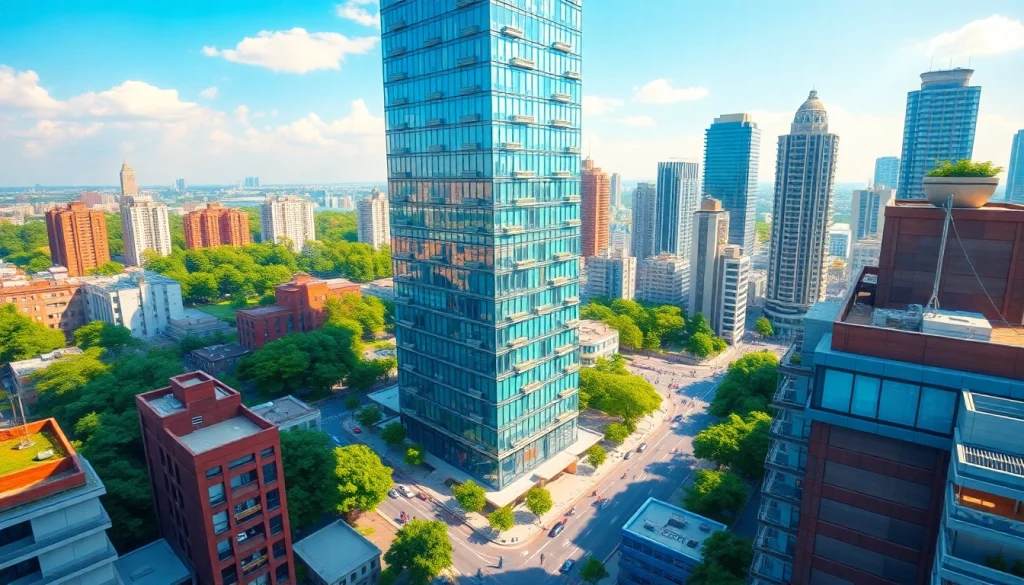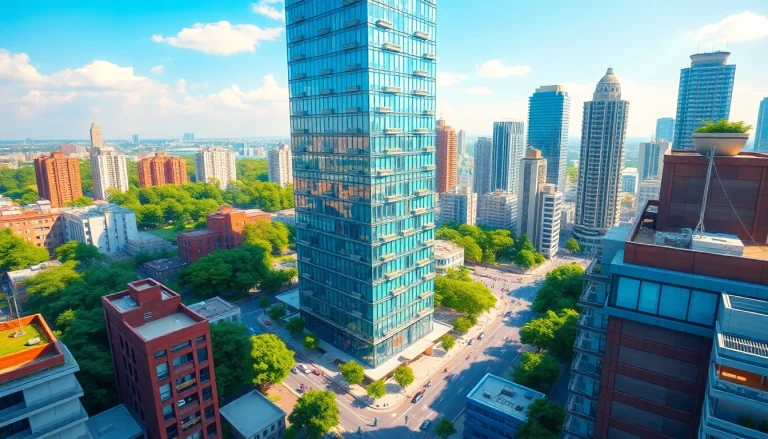
Introduction to Sim Tower
Sim Tower, formally known as SimTower: The Vertical Empire, is a pioneering construction and management simulation video game that has captivated players since its release in 1994. Developed by OPeNBooK and published by various entities outside Japan, Sim Tower has become a lasting icon in the gaming world. The game invites players to design, build, and manage a skyscraper, allowing them to shape a bustling vertical metropolis filled with a myriad of facilities and amenities. This unique simulation experience combines strategy, creativity, and resource management, making it a cherished title among fans of management games. For those interested in experiencing the thrill of creating their own skyscraper, you can find the game available for play sim tower.
Overview of Sim Tower Gameplay
Sim Tower allows players to construct a high-rise building from the ground up while managing various aspects of tower development. Players start with a foundation and a vision—whether they want to create a luxury hotel, office space, or residential apartments. The gameplay mechanics encourage strategic thinking as players must consider the placement of amenities, elevators, and services to ensure a harmonious and efficient environment.
The essence of Sim Tower lies in its emphasis on verticality. Unlike conventional building simulations that focus on horizontal expansion, this game challenges players to optimize the limited vertical space available. Players face the dual challenge of attracting tenants and managing operational efficiency. The game employs a 2D graphical interface, and while the visuals may appear simplistic compared to modern games, the depth of strategy involved remains profound.
The History of Sim Tower
Released in 1994, Sim Tower was the brainchild of Japanese designer Yoot Saito. It debuted on Microsoft Windows and Macintosh platforms and was soon recognized for its innovative take on a simulation genre that was gaining popularity in the 1990s. After its original release, it was eventually brought to other systems, including the PlayStation and SEGA Saturn, thus expanding its reach to a wider audience.
Over the decades, Sim Tower has evolved from a pioneering simulation game into a nostalgic classic, praised for its engaging gameplay and iconic status. While other simulation games have come and gone, Sim Tower retains a loyal fanbase who frequently engage in discussions, share gameplay tips, and create user-generated content. Its enduring popularity can be attributed to its unique concept of vertical management, universal appeal across ages, and its ability to provide endless replayability.
Why Sim Tower Remains Popular Today
The sustained popularity of Sim Tower is a testament to its timeless design and engaging mechanics. Players still find enjoyment in building and managing their towers, showcasing the game’s enduring appeal. Various factors contribute to its lasting legacy:
- Strategic Complexity: Players can engage in deep strategic thinking by optimizing their tower’s layout, ensuring tenant satisfaction, and balancing operational costs.
- Nostalgic Value: Many gamers hold fond memories of playing Sim Tower during their childhood, leading to a strong nostalgic pull that encourages new generations to explore this classic title.
- Community Engagement: A vibrant online community continues to discuss strategies, share experiences, and reminisce about their favorite moments, thereby keeping the game alive through active player involvement.
Essential Strategies for Success in Sim Tower
Planning Your Tower Layout
The layout of your tower is crucial for maximizing tenant satisfaction and operational efficiency. Here are key strategies to consider when planning your layout:
- Vertical Zoning: Divide your tower into distinct zones – residential, commercial, and recreational. This will ensure that tenants have access to necessary amenities without needing to navigate long distances.
- Elevator Placement: Elevators are the lifeline of your tower. Strategically position them for optimal access to different tower levels. Consider the foot traffic when deciding elevator locations.
- Service Accessibility: Ensure that essential services such as restrooms, security, and maintenance are easily accessible to all tenants. This will improve tenant satisfaction and reduce complaints.
Optimizing Amenities for Resident Satisfaction
A key element in Sim Tower is ensuring that your tenants’ needs are met through various amenities and services. Here are some best practices for optimizing amenities:
- Balancing Amenities: Offer a mix of amenities suitable for different tenant types, such as offices, retail spaces, and recreational areas. Providing diverse options will attract a wider range of tenants.
- Monitoring Satisfaction: Keep an eye on tenant feedback and satisfaction levels. Adjust amenities according to their needs and preferences, ensuring a happy and thriving community.
- Implementing Upgrades: As your tower grows, consider upgrading existing amenities or introducing new ones to enhance the overall tenant experience. Upgrades can include better security systems, modernized recreational facilities, or increased office space.
Managing Resources and Finances
Effective financial management is essential for a successful tower operation in Sim Tower. Players should adopt the following financial strategies:
- Budgeting Wisely: Keeping track of expenses—construction, maintenance, and utilities—is crucial for sustainability. Prioritize spending within your budget while still investing in growth.
- Revenue Generation: Explore diverse revenue streams, including retail rental income and services offered within tower amenities. This will diversify financial resources and reduce risk.
- Cost-Benefit Analysis: Regularly assess the profitability of amenities and services. If something is draining resources without adequate return, consider replacing or upgrading it.
Common Challenges Players Face in Sim Tower
Dealing with Traffic and Access Issues
Traffic congestion and access delays can significantly impact tenant satisfaction in Sim Tower. Here are solutions for mitigating these challenges:
- Elevator Management: Ensure that your elevators can handle the number of tenants efficiently. Consider adding more elevators or upgrading existing ones to increase speed and capacity.
- Emergency Exits: Provide sufficient emergency exits to manage tenant movement during emergencies effectively. This will also improve general access and reduce bottlenecks.
- Clear Pathways: Make sure that pathways within the tower are clear and well-planned, allowing tenants to navigate without confusion or obstruction.
Handling Frustrated Tenants
Frustrated tenants can lead to complaints and decreased satisfaction, impacting your tower’s overall performance. To better manage tenant relations, consider the following:
- Proactive Communication: Regularly communicate with tenants regarding any ongoing issues or changes within the tower. This can alleviate frustration and build goodwill.
- Quick Response to Complaints: Address tenant complaints promptly and effectively. A well-managed complaints system can turn a negative experience into a positive one.
- Improving Amenities: Actively seek tenant feedback to identify areas that require improvement, ensuring that you are meeting their needs and expectations.
Adapting to Environmental Factors
In Sim Tower, environmental factors like weather and external events can affect the tower’s functionality and tenants’ overall experience. Players should be ready to adapt:
- Sustainability Practices: Consider eco-friendly upgrades and energy-efficient amenities. This not only reduces operational costs but also meets tenant expectations for sustainability.
- Emergency Preparation: Be prepared for emergencies, such as natural disasters. Having contingency plans in place can help preserve tenant safety and maintain a sense of stability.
- Seasonal Strategies: Innovate with seasonal adjustments, such as creating outdoor spaces for summer or festive decorations for winter that maximize tenant engagement and enjoyment.
Advanced Tips and Tricks for Mastering Sim Tower
Design Innovations for Higher Scores
To achieve the highest scores in Sim Tower, players should implement innovative design strategies that enhance gameplay:
- Vertical Gardens: Integrate green spaces like vertical gardens to improve aesthetics and tenant satisfaction. This can also positively impact air quality and overall building ambiance.
- Smart Floor Planning: Optimize floor design for commercial spaces to ensure a high occupant turnover rate. A well-designed floor can maximize tenant retention and satisfaction.
- Unique Architectural Features: Incorporate unique architectural elements like observation decks or open terraces to attract more tenants and create a memorable skyline.
Utilizing Community Feedback
Feedback from the community of Sim Tower players can be invaluable in refining strategies and improving gameplay experience. To leverage this feedback:
- Engage Online: Participate in forums and discussion boards where players share their experiences and techniques. Learning from others can provide insights into successful tower development.
- User-Generated Content: Consider utilizing user-generated layouts and designs as inspiration for your tower. The creative strategies of fellow gamers can offer fresh perspectives.
- Adapt Strategies: Use collective feedback to refine your own gameplay strategies. What works for others might be an innovative solution to challenges faced in your own tower.
Strategies for Expanding Your Tower
Once players have established a solid foundation, expanding the tower becomes a thrilling endeavor. Here’s how to navigate expansion effectively:
- Phased Expansion: Plan your expansion in phases to manage resources efficiently. Each phase should focus on enhancing a specific area of the tower.
- Market Research: Assess demand for different types of spaces as you expand. Understand what tenants are looking for and cater to those needs to ensure high occupancy rates.
- Collaboration with Community: If the community provides tools or insights for expansion, utilize those resources. Whether it’s layout ideas or design inspirations, community engagement can facilitate smooth transitions.
Future of Management Simulation Games Like Sim Tower
Emerging Trends in Simulation Games
The landscape of management simulation games continues to evolve, and several emerging trends can be observed:
- Realistic Graphics: Today’s games often feature upgraded graphics that enhance the player’s immersive experience. Players may expect visually appealing surroundings paired with engaging gameplay.
- Incorporation of AI: Advanced AI capabilities can create more dynamic and responsive gameplay environments where tenants and challenges evolve over time.
- Cross-Platform Play: The future may see cross-platform functionality allowing players to access their games across multiple devices, enhancing convenience and reach.
The Role of Community and Modding
The community of players and modders plays an integral role in the ongoing success of games like Sim Tower. The possible contributions include:
- User-Created Mods: Community members often create mods that enhance gameplay, introduce new features, or alter existing mechanics, giving the game longevity and vibrancy.
- Active Discussions: Maintaining an active dialogue within the community fosters a collaborative environment for sharing insights, providing support, and exploring collective experiences.
- Event Participation: Community events, tournaments, or collaborative projects can contribute to player engagement and draw in new players while rewarding loyalty among existing enthusiasts.
Comparisons with Newer Titles
As gaming continues to innovate, newer management simulation titles also emerge to capture players’ interests. While Sim Tower retains its unique charm, observing new influences can present valuable lessons:
- Gameplay Depth: Newer simulation games often focus on narrative-driven experiences with complex characters and plotlines, enhancing emotional engagement for the player.
- User Interface Improvements: Modern games feature refined user interfaces that streamline gameplay, making it accessible and intuitive for players of all skill levels.
- Focus on Community Interaction: Incorporating social elements and community-related activities within gameplay enhances player motivation and builds community ties.



